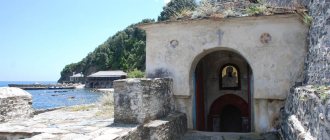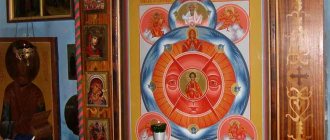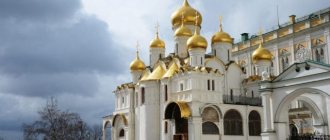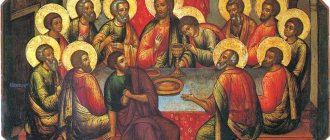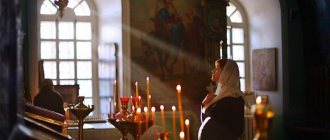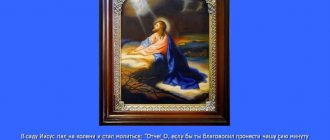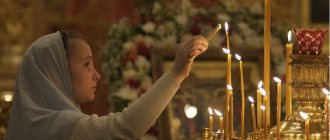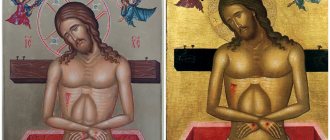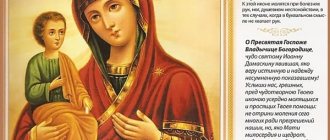According to legend, the image of the Savior not made by hands is the very first Orthodox image that immortalized the image of the Lord God. The role of this icon is very important for every Christian; quite often this shrine is put on a par with the Life-Giving Cross and the Lord’s Crucifixion. Since ancient times, Orthodox people have shown interest in the meaning of the icon of the Savior Not Made by Hands, and in what cases they turn to it for help.
Dear Brothers and Sisters, we will be very glad if you subscribe to our group on VK, there you will find even more prayers, icons and other interesting information, here is the address link - Orthodox group! Or our Orthodox group in Odnoklassniki! We are also pleased to remind you that on the pages of our church store you can find all possible Orthodox goods!
Image given by God
The image of Christ “Savior Not Made by Hands” is rightly called the first icon of Jesus Christ. Its uniqueness lies in the fact that the face of the Savior was not fixed by a human hand (hence the name “Not Made by Hands”). This is an imprint of the face of Jesus Christ on the canvas - ubrus. Subsequently, the image became iconographic and began to be depicted on icons. From a formal point of view, all modern icons are the work of icon painters and artists, and only the prototype is not made by hands.
The Savior Not Made by Hands (Novgorod icon of the 12th century, Tretyakov Gallery)
Testimonies of Jesus' Contemporaries
It is impossible to briefly tell the story of the Savior Not Made by Hands. The very first detailed description of the appearance of Jesus Christ was left to us by the proconsul of Palestine Publius Lentulus in his letter to the Roman Caesar: “This man is multi-talented. His name is Yeshua Ha-Mashiach. He has a beautiful and noble face, a harmonious body structure. His hair is the color of ripe walnut. Strength and calm emanate from his face. It is ruddy and without a single blemish. His eyes are blue and radiant.”
Only most historians consider this letter to be a fake, because proconsul Publius Lentulus does not appear in the annals of Roman history. The very first drawn images of Jesus Christ, which history has preserved for us, depicted the Savior looking more like a typical Roman than a Jew or Greek. Decent clothes of a Roman citizen, short-cropped hair, clean-shaven face. In the first written evidence about the appearance of the Savior, Jesus Christ was portrayed as an unprepossessing man. So what was he really like? Is there at least one plausible description of it? At least one lifetime portrait? Yes, it exists. More precisely, it existed.
The Savior Not Made by Hands: the history of the origin of the image
According to Church Tradition, the history of the origin of the icon dates back to the time of the Savior’s earthly life. The ancient city of Edessa (modern Sanliurfa in southeastern Turkey) was ruled by Avgar Uhama. He was terminally ill with leprosy. The ruler learned about Jesus Christ, who performed many miracles, including healing the hopelessly sick. Abgar sent his servant Ananias to Palestine. The servant was ordered, if the Savior could not come himself, to depict him on canvas.
The painter, due to the large crowd of people who always surrounded Jesus Christ, was unable to paint His Face. The Lord could not visit Abgar, but promised to send one of His disciples to him. Having learned about Ananias’ desire to portray Him, Christ ordered to bring water and a towel. He washed himself, wiped His Face, and miraculously an imprint of His face remained on the canvas. This is how the miraculous image of the Savior was revealed to the world. This image was brought to the ruler of Edessa, after which Abgar was healed of leprosy.
The emergence of the first image
Church tradition has preserved few descriptions of Christ’s appearance, and the Bible doesn’t say a word about it at all. But where did the image of that face that everyone knows well come from? The history of the icon “Savior Not Made by Hands” was brought to us in all its details by the Roman historian Eusebius, a student of Pamphilus, originally from Palestine. Much information about the life of that period is known precisely thanks to his works.
The glory of Christ was so great that people came to Him even from other countries. So the ruler of the city of Edessa (in the territory of modern Turkey) sent a man to him with a letter. Avgar was already grown, he was tormented by a leg disease. Christ promised to send one of his disciples to help the king and enlighten his people with the light of the Gospel. Ephraim the Syrian also talks about this incident.
Abgar also sent the artist to Christ, but he was so blinded by the divine radiance that he simply could not paint a portrait of the Savior. Then Christ gave the king as a gift a linen (ubrus), with which he wiped his face. The imprint of the face remained on the board - that’s why it is called miraculous - because it was created not by human hands, but by divine power (like the Shroud of Turin). This is how the first icon arose - during the life of the Savior. The ambassadors brought the fabric to Edessa, where it became a city shrine.
Work as a courier at Yandex.Eda (up to 3,400 rubles per shift) leave a request →
After the ascension of Christ, the Apostle Thaddeus went there - he healed Abgar, performed many more miracles and converted the local residents to Christianity. Another historian, Procopius of Caesarea, testifies to these events. And Evagrius from Antioch tells how the image miraculously saved the inhabitants of the city from an enemy siege.
The fate of the iconographic image
Subsequently, Edessa was visited by the apostles Thomas and Thaddeus, who converted the local residents to Christianity. The miraculous image of Jesus Christ was placed above the city gates. Everyone passing through them had to give praise to Jesus Christ. After some time, Christians were persecuted by the authorities. To save the icon, it had to be walled up in the fortress wall. There it remained intact until 545.
Edessa was besieged by the Persian king. The Mother of God appeared to Bishop Eulavius in a dream and indicated the place in the wall where the image was kept. The Savior not made by hands was found, but at the same time another image of Jesus Christ was discovered on the brickwork. After the religious procession was carried out with the icon, the Persians retreated and the city was liberated.
After the conquest of Edessa by the Ottomans in 944, the Savior Not Made by Hands was transferred to Constantinople to the Temple of the Wisdom of God. In honor of the transfer of the image of the Savior to Constantinople, the Church established a holiday, which is celebrated on August 16 (29). Unfortunately, the image was lost and its further fate is unknown. According to one assumption, the Savior Not Made by Hands was kidnapped in 1204 by the crusaders who headed to Venice. But the ship sank in the Sea of Marmara along with the lining.
Miraculous deeds of the image
The first miracle associated with this image occurred immediately after the ubrus was delivered to King Abgar. The king was healed, but his face still bore traces of illness. Later, when the Apostle Thaddeus came to the city and baptized Abgar, he, coming out of the font, was completely healed. After this, the Holy Shroud with the Face of the Savior, filled with miraculous power, was mounted on a board and installed above the city gates of Edessa. Later, the Savior Not Made by Hands was transferred from Edessa to Constantinople. During the journey to Constantinople, numerous cases of healing occurred continuously around the procession.
Icon “Savior Not Made by Hands” in the temple
The miraculous discovery of the image in the St. Boris-Gleb Monastery
The miracle of the appearance of the Savior Not Made by Hands in the St. Boris-Gleb Convent occurred in 1997. Initially, the ancient icon of the Savior belonged to an ordinary woman. After the Great Patriotic War, the image became very dark, and at the end of the century it was transferred to the monastery. The transformation of the image of the “Savior Not Made by Hands” took place on July 20 during the Divine Liturgy, when a flash of light illuminated the icon. The renewed icon smelled fragrant for five days. A diocesan commission was created, which confirmed the fact of the miraculous renewal of the icon of the Savior Not Made by Hands.
Theological interpretation of ubrus and its veneration
The holy image of the Son of God, left to Christians by the Savior himself, reminds people of the incarnation of Jesus, His suffering, death on the cross and the atonement for sins given to all humanity - as proclaimed by the VI Ecumenical Council (787). Prayer in front of this icon helps to cleanse the soul, enlightens, heals the soul and body, protects from temptations, dangers, and ill-wishers.
The relic has long been an important part of Christian tradition. In particular, it is used to bless newlyweds for a long and happy life together. The face should be placed in the top row of the iconostasis, and on the days of commemoration of the image, known as the Apple (August 19) and Honey (August 29) Savior, a lamp should be lit in front of it. In addition, more than one temple of the Savior Not Made by Hands was erected in honor of the shrine. There are them in Kyiv, and in Kharkov, and in other Ukrainian cities.
Spas Mokraya Brada (Soaked Vlas) XV century. / Savior Not Made by Hands. Second half of the 16th century.
Iconography of the image
There are several types of writing for the “Savior Not Made by Hands” icon. An important feature of the icon is that it depicts only the face of Jesus Christ on the canvas. In some cases - on a brown or gold background. The second spelling is sometimes called “Spas on the chrepiya,” that is, on the tiles. The name is given in memory of the event when the image of the Savior appeared on the wall in Ephesus.
It is this type of icon that is currently in the Tretyakov Gallery; its creation dates back to the 12th century. This special image was painted by a master from Novgorod and is distinguished by the majesty of the image. In the icon, the Savior is depicted with open eyes, his face does not express emotions, and is calm.
Icons have been preserved that could be painted based on the original image.
Now it is no longer possible to recognize what the face of Christ looked like on the towel. But there are several images that are believed to be painted based on the original image:
1 Mandylion from the Temple of San Silvestro in Capite.
Mandylion from the Temple of San Silvestro in Capite, possibly copied from the original face of Christ
2 Mandylion from the Armenian Church of St. Bartholomew in Genoa.
Mandylion from the Armenian Church of St. Bartholomew in Genoa
3 Triptych of the Monastery of St. Catherine in Sinai.
The doors of the triptych of the monastery of St. Helena tell the story of the Savior
Icon of the Savior Not Made by Hands: what helps, prayers
Before the Image of the Savior Not Made by Hands, they pray for healing from mental and physical illnesses, for the granting of strong, sincere faith in difficult moments of life. Just as Abgar, by faith in the Savior, was healed of an incurable illness, so many people, praying with faith before the icon of the Savior Not Made by Hands, receive what they asked for.
One of the miraculous images of the Savior Not Made by Hands is located in the Transfiguration Cathedral in St. Petersburg. The icon was painted by the famous icon painter Simon Ushakov in 1676 for the royal family. Emperor Alexander III carried a list of this miraculous icon with him. During the crash of the Tsar's train on the railway on October 17, 1888, he emerged unharmed from the destroyed carriage along with his entire family. The icon of the Savior Not Made by Hands was also preserved intact, even the glass in the icon case remained intact.
Where can I find the lists?
The list is an icon that partially copies another rare icon. They are made to be sent to various Christian churches wishing to have a rare, miraculous icon at their disposal. Lists of the “Savior Not Made by Hands” can be found in the following places:
- The Tretyakov Gallery houses within its walls one of the earliest icons depicting Jesus Christ - the Novgorod double-sided image, painted in the 12th century;
- in the Transfiguration Cathedral, located in the city of St. Petersburg;
- in Tutaevsky Resurrection Cathedral;
- at the State Museum of Art of Georgia;
- in St. Peter's Basilica, Vatican City;
- at the Monastery of St. Catherine, Mount Sinai.
Icons are divided into two types:
- Spas on the ubrus;
- Spas na chrepii.
Ubrus is a light-colored canvas, and chrepiye refers to images on tiles or ceramics.
Prayer
O Most Blessed Lord Jesus Christ, our God! You, from the ancient times of human nature, washed your face with holy water and wiped it with a rubbish, and you deigned to depict it miraculously on the same fringe and sent it to the Edessa prince Abgar for the healing of his illness. Behold, now we, Thy servants, sinners, possessed by our mental and physical ailments, seek Thy face, O Lord, and with David in the humility of our souls we call: do not turn Thy face away from us, and turn away in anger from Thy servants, be our Helper, not reject us and do not abandon us. O All-Merciful Lord, our Savior! Imagine for Yourself in our souls, that if we live in holiness and truth, we will be Your sons and heirs of Your Kingdom, and so we will not cease to glorify You, our Most Merciful God, together with Your Beginning Father and the Most Holy Spirit, forever and ever. Amen.
Read us conveniently on social networks:
Tags: icon of the Savior, image of Jesus Christ not made by hands, Savior Not Made by Hands, Savior Not Made by Hands icon

